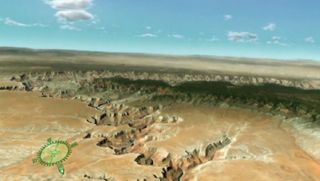
See the Grand Canyon From Your Computer

Want to see the Grand Canyon but can't make the trip? Now there's a virtual aerial tour from the National Park Service to tide you over, complete with a narration about the canyon's geography and history.
The tour starts to the north of Grand Canyon National Park at Lee's Ferry, where rafters set out to explore the Colorado River, which carved the canyon over the course of about 6 million years.
The animation then flies over much of the 277 miles (446 kilometers) of the canyon, which reaches depths of one mile (1.6 km) and is some 18 miles (29 km) across in places.
Along the way, the narrator points out different layers of rock that the river cuts through, the first being whitish-gray Kaibab limestone that formed about 270 million years ago. [Watch the Grand Canyon video.]
The river divides the region into two plateaus, known as the North Rim and South Rim of the canyon. About 4.5 million people visit the park each year to take in the spectacular view from the South Rim. From here visitors can descend into the canyon along the Bright Angel Trail, a popular path named for the fault that ruptured the cliff.
Across the way is the North Rim, which reaches 9,000 feet (2,743 meters) in elevation. Nearby is Crystal Creek, where a large 1966 storm caused a surge of debris that impeded the river and created one of the toughest rapids on the Colorado River.
Next is Powell Plateau, an eroded remnant of the North Rim named for geologist and explorer John Wesley Powell, who in 1869 became the first person to survey and map the Grand Canyon.
Sign up for the Live Science daily newsletter now
Get the world’s most fascinating discoveries delivered straight to your inbox.
Nearby is Havasu Creek, famous for its blue-green water, waterfalls and pools. It's the ancestral homeland of the Havasupai, or "People of the Blue-Green Waters," according to the tour narrator.
Another notable site is Vulcan's Throne, the remnant of an ancient volcano. Beginning 630,000 years ago, lava poured forth over the canyon rim from volcanoes such as this, damming the river at least 13 times. Each time, water collected behind the dams and eventually built up enough pressure to cause a catastrophic collapse. Volcanic eruptions came to an end about 10,000 years ago.
The tour also features Separation Canyon, named because it was here that three of Powell's men left his expedition in 1869, never to be seen again.
Caves throughout the canyon contain the remains of large Ice Age mammals, such as giant ground sloths, camels, mastodons and horses. The discovery of Clovis-style spear points indicates that Ice Age hunters also dwelled within the canyon's walls 12,000 years ago.
Follow OurAmazingPlanet on Twitter @OAPlanet. We're also on Facebook and Google+.

